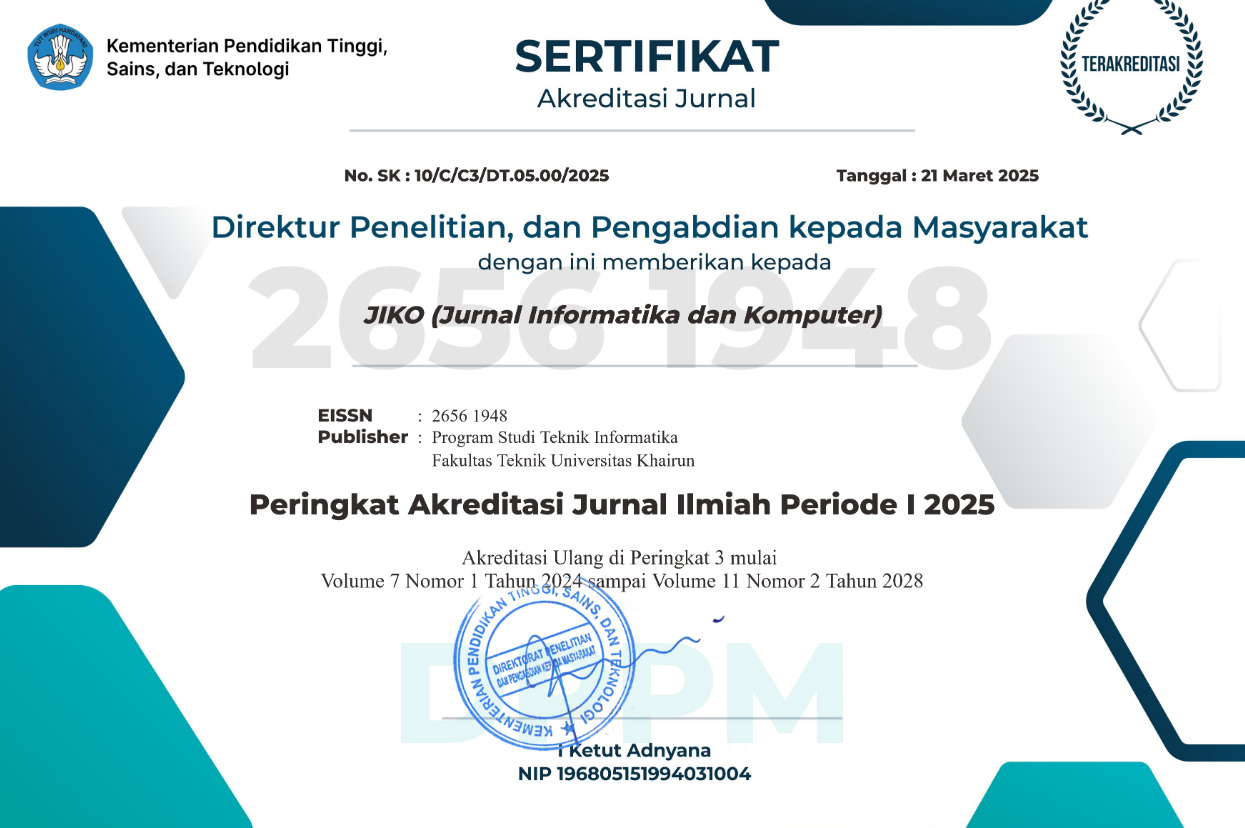ENHANCED NETWORK SECURITY USING ZERO TRUST IN SMART HOME NETWORKS AGAINST MAN-IN-THE-MIDDLE ATTACKS
Abstract
Full Text:
PDFReferences
A. Roy, A. Dhar, and S. S. Tinny, “Strengthening IoT Cybersecurity with Zero Trust Architecture: A Comprehensive Review,” 2024, doi: 10.61424/jcsit.
A. Johanes, N. Filzah, M. Radzuan, and Z. H. Abdullah, “Implementation of A Zero-Trust Approach in Smart Home Among the Houseowners in Kota Kinabalu, Sabah.”
“Evaluasi Pengujian Keamanan Arsitektur Zero Trust Network Pada Jaringan Smart Home Untuk Mengatasi Serangan Data Sniffing.” [Online]. Available: https://lib.mercubuana.ac.id
S. Supiyandi, C. Rizal, M. Iqbal, M. N. H. Siregar, and M. Eka, “Smart Home Berbasis Internet of Things (IoT) Dalam Mengendalikan dan Monitoring Keamanan Rumah,” Journal of Information System Research (JOSH), vol. 4, no. 4, pp. 1302–1307, Jul. 2023, doi: 10.47065/josh.v4i4.3822.
Y. Kusnanto, M. A. Nugroho, and R. Kartadie, “JIPI (Jurnal Ilmiah Penelitian dan Pembelajaran Informatika) Journal homepage: https://jurnal.stkippgritulungagung.ac.id/index.php/jipi IMPLEMENTASI ZERO TRUST ARCHITECTURE UNTUK MENINGKATKAN KEAMANAN JARINGAN: PENDEKATAN BERBASIS SIMULASI,” vol. 9, no. 4, pp. 2357–2364, 2024, doi: 10.29100/jipi.v4i1.6943.
P. Srinivasan, “Zero Trust Network Architecture.”
H. Zhang, Q. Wang, X. Zhang, Y. He, B. Tang, and Q. Li, “Toward Zero-Trust IoT Networks via Per-Packet Authorization,” IEEE Communications Magazine, 2024, doi: 10.1109/MCOM.001.2300390.
Z. Adahman, “ZERO-TRUST ARCHITECTURE AND ITS COST-EFFECTIVENESS ON NETWORK SECURITY A Paper.”
A. Talan, “Zero Trust Network Access with Cybersecurity Challenges and Potential Solutions MSc Research Project M.Sc. in Cybersecurity.”
A. Z. Alalmaie, P. Nanda, and T. X. He, “ZT-NIDS: Zero Trust-Network Intrusion Detection System Validation based on Attack Simulations.” [Online]. Available: https://orcid.org/0000-0001-8962-540X
M. Andreou and R. Project, “Zero Trust Network Security Model in containerized environments,” 2020.
N. I. Roslan, N. T. Mazman, and N. F. A. Johari, “Zero Trust Architecture: A Paradigm Shift in Network Security,” Jul. 22, 2024. doi: 10.36227/techrxiv.172165641.12548858/v1.
A. Gokhale and S. Kulkarni, “Enhanced Zero Trust Implementation -- a novel approach for effective network policy management and compliance tracking,” May 27, 2023. doi: 10.22541/au.168517996.68474374/v1.
M. A. Allouzi and J. Khan, “Enabling Zero Trust Security in IoMT Edge Network.”
P. Dhiman et al., “A Review and Comparative Analysis of Relevant Approaches of Zero Trust Network Model,” Feb. 01, 2024, Multidisciplinary Digital Publishing Institute (MDPI). doi: 10.3390/s24041328.
N. Faizah Rozy, I. Muhamad Malik Matin, T. Informatika, F. Sains dan Teknologi, and U. Syarif Hidayatullah Jakarta, “UJI KERENTANAN SMART HOME MENGGUNAKAN METODE SQUARE UNTUK MENDUKUNG SMART CAMPUS,” 2021.
H. Fereidouni, O. Fadeitcheva, and M. Zalai, “IoT and Man-in-the-Middle Attacks,” Aug. 2023, doi: 10.1002/spy2.70016.
R. Rahman, A. F. Rahman, and S. Artikel, “Technology Sciences Insights Journal Penerapan Zero Trust Network Access (ZTNA) dengan penggunaan CAPTCHA pada website umum INFORMASI ARTIKEL ABSTRAK,” 2024.
W. R. Simpson and K. E. Foltz, “Resolving Network Defense Conflicts with Zero Trust Architectures and Other End-to-End Paradigms,” International Journal of Network Security & Its Applications, vol. 13, no. 1, pp. 1–20, Jan. 2021, doi: 10.5121/ijnsa.2021.13101.
R. Syrotynskyi, I. Tyshyk, O. Kochan, V. Sokolov, and P. Skladannyi, “Methodology of network infrastructure analysis as part of migration to zero-trust architecture ⋆,” 2024.
N. F. Syed, S. W. Shah, A. Shaghaghi, A. Anwar, Z. Baig, and R. Doss, “Zero Trust Architecture (ZTA): A Comprehensive Survey,” 2022, Institute of Electrical and Electronics Engineers Inc. doi: 10.1109/ACCESS.2022.3174679.
P. Phiayura and S. Teerakanok, “A Comprehensive Framework for Migrating to Zero Trust Architecture,” IEEE Access, vol. 11, pp. 19487–19511, 2023, doi: 10.1109/ACCESS.2023.3248622.
DOI: https://doi.org/10.33387/jiko.v8i2.10329
Refbacks
- There are currently no refbacks.












